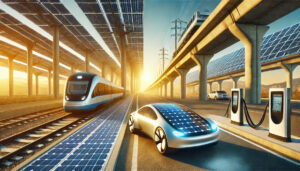
Picture a world where your daily commute has no carbon footprint and the energy that powers your vehicle comes straight from the sun. This vision is becoming a reality—solar-powered transportation is leading us toward a cleaner, greener future. From cars and buses to trains and boats, solar energy is changing the way we move.
What is Solar-Powered Transportation?
Solar-powered transportation refers to the use of energy captured from the sun to operate vehicles and transport systems. Solar panels convert sunlight into electricity, which is then utilized to power electric motors or recharge batteries. This cutting-edge approach is not only eco-friendly but also has the potential to transform modern travel.
Why is Solar-Powered Transportation Important?
The global transportation sector is a major contributor to carbon emissions. By adopting solar-powered alternatives, we can:
Cut Down on Emissions: Solar-powered vehicles generate zero emissions, aiding in the fight against climate change.
Reduce Fossil Fuel Dependency: As a renewable resource, solar energy removes the reliance on finite, polluting fossil fuels.
Lower Costs Over Time: Once installed, solar panels provide free energy, significantly cutting down on fuel and operational costs.
Innovative Examples of Solar-Powered Transportation
Solar Cars
Solar cars are crafted with lightweight materials and efficient panels to optimize sunlight absorption. Companies like Lightyear and Aptera are at the forefront of this innovation, developing vehicles that can travel hundreds of kilometers using only solar energy.
Solar Trains
Solar-powered trains are gaining traction in countries like India, where train carriages are fitted with solar panels to power lights, fans, and other systems. This helps decrease diesel consumption and operational expenses.
Solar Buses
Public transport is becoming more sustainable with solar-powered buses. These vehicles are ideal for urban settings, providing clean, eco-friendly solutions for everyday commutes.
Solar Boats
Perfect for eco-tourism and transport on waterways, solar boats operate entirely on sunlight. They are especially favored in delicate ecosystems, helping to minimize water pollution.
Solar Charging Stations
Charging stations that utilize solar energy are becoming essential in the electric vehicle (EV) landscape. These stations ensure that electric vehicles remain environmentally friendly by relying on renewable energy for charging.
How Does Solar Energy Work for Transportation?
Solar Panels: Capture sunlight and convert it into electricity.
Battery Systems: Store surplus energy for use when sunlight isn’t available.
Electric Motors: Utilize the stored electricity to power vehicles, providing a smooth and quiet ride.
Challenges Solar-Powered Transportation Faces
While the potential is significant, the path to widespread use comes with hurdles:
Weather Dependency: Limited sunlight during cloudy or rainy days can impact performance.
High Initial Costs: The upfront investment for solar-powered vehicles and infrastructure can be substantial, although long-term savings can offset this.
Energy Efficiency: Current solar panel technology only converts a fraction of sunlight into electricity, necessitating ongoing advancements.
Why the Future is Bright for Solar Transportation
Deshhhccpite these obstacles, progress in solar technology is swiftly making solar-powered transportation more viable and efficient. Governments and businesses around the globe are investing in this sustainable future, motivated by the urgent need to address climate change.
Solar-powered transportation represents more than just a response to current environmental issues—it’s a significant step toward a sustainable future. By cutting emissions and lowering energy costs, this groundbreaking technology is transforming how we travel.
At WattValley, we are committed to fostering a future powered by the sun. Discover our range of solar solutions.





